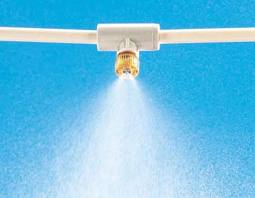 A misting system is a great idea for cooling down the air outside. These systems can cool the air by 20 degrees, but they do need occasional maintenance.
A misting system is a great idea for cooling down the air outside. These systems can cool the air by 20 degrees, but they do need occasional maintenance.
Most of the systems we see are purchased at the big box stores. These systems are all-in-one systems and you can add to them if you need to. They would be considered the lower end of the quality scale, as they don’t have many bells and whistles as custom systems do.
It is common to see the system dripping, particularly from the area of the nozzles. This doesn’t necessarily mean that there is a leak though. The pressurized water sprays out of the misting nozzles and as water sprays out, it collects on the nozzle itself. When enough water mist collects, it forms a droplet and falls to the ground. So you will see some small drops of water under each nozzle. I wouldn’t worry about it too much.
If the nozzle isn’t spraying at all, then you can worry. It is clogged up with mineral deposits and is blocking the nozzle from operating. You might be able to pick at it and get it spraying again, but most likely you will need to remove it and clean it out.
You can use a toothbrush and a mild vinegar/water mixture. Let the nozzle sit there for awhile and then brush the deposits away with the toothbrush.
 A misting system works great…when it actually works. These systems need light maintenance due mainly to the water. The water leaves deposits which gradually restrict the tiny orifices in the nozzles until you get a constant drip from the nozzle…without the cooling mist. What you will see is just a puddle of water below the nozzle.
A misting system works great…when it actually works. These systems need light maintenance due mainly to the water. The water leaves deposits which gradually restrict the tiny orifices in the nozzles until you get a constant drip from the nozzle…without the cooling mist. What you will see is just a puddle of water below the nozzle.
Fortunately, the misting system nozzles can be cleaned out rather easily. You will need to turn the water off to the system and unscrew the misting nozzles. Just the nozzle tip will come off and that is all you need. While you have the tip off, turn the water back on and blow out any debris that may sitting in the line, then turn it back off.
Take the nozzle tips and try soaking them in warm vinegar. You can also try a cleaning solution such as CLR, but read the label first. Vinegar is cheap and most people already have some in their homes. Let them soak for 15 minutes or so and then grab a small brush. Something along the lines of an old toothbrush will work nicely. The deposits should be loosened up by the vinegar and a good brushing will help to remove the build-up. Work the brush inside the tip and outside. Rinse it out and blow air through it. You should be able to hear a slight hissing. When it hisses, you are done. Replace the tip and turn the water back on to test it.

Even with a patio cover to keep the sun at bay, it's still hot out there. Have you ever thought of a misting sytem installation? A misting system can cool things down by as much as 20 degrees.
There are two types of systems available, both of which can be found at a home center. Expect to pay anywhere from $40 to $200 depending upon how many linear feet you'll need.
The first and least expensive system is made up of half-inch PVC pipe with nozzles that are built into half-inch couplings that glue onto the piping. All you need to do is buy the number of nozzles needed, some fittings to attach it to the water supply, glue it all together then hang it from the patio cover. This system is unsightly, though, because it's bulky and the glue can run down the piping if you're not careful.
The other system uses three-eighths inch flexible hose, and no glue. This kit's base cost is around $40 and is enough to cover about 12 linear feet of mist area. All of the necessary fittings are included. Although more expensive than the other system, the nozzles are brass and the hose is easy to maneuver. It is also less noticeable than the PVC pipe. In addition, you can add more lengths of tubing and nozzles to your heart's content.
Regardless of which system you choose, the first step in its assembly is to connect the water feed line to the water source. Usually, the hose spigot is handy. If you're using PVC, you'll need to purchase a fitting and a valve to tie into the water supply (This usually involves sweating the fitting on.). For the hose system, just slip the brass hose adapter (It's also included in the kit.) onto the end and screw it onto the spigot. At this point, turn the water on and blow out any debris in the hose.
If your patio cover is made of wood, use the hanging clamps that come in the kit because they have nails that will hold the hose securely to the wood. If your patio cover is made of aluminum, don't use these clamps. Instead, use plastic cable clamps (about $2 for a pack of 20). Use five-eighths inch self-tapping screws to hold them in place.
Now you're ready to bring the hose up the wall, just to the underside of the patio cover. You'll have to decide if you want to mount the nozzles on the inside, the underside or the outside of the patio cover. (If you mount them on the outside, they won't be visible, but your ability to direct the mist may be impeded.)
If you're mounting the nozzles between 8-feet and 10-feet high, space them 24 inches apart and at least 24 inches from the house.
For the PVC system, you'll need to prime and glue the fittings together. For the hose system, just push the hose into the nozzle and twist. Pull out on the outer ring of the nozzle to lock in the hose. Secure each nozzle by attaching a clamp three inches from either side of the nozzle.
To change the direction of the mist line, use 90-degree elbows and tee fittings. The brass fittings for the hose system cost about $5 each. For the PVC, the fittings are about 50 cents each.
Cut the PVC with a PVC pipe cutting tool (about $12); it makes a perfectly smooth cut. I would discourage you from using a hacksaw, because the burrs left on the end of the pipe may clog the nozzles. You can also use the pipe cutting tool or a sharp utility knife to cut the tubing on the other system.
Follow the perimeter of the patio cover until you've reached the end of the mist line, where you will cap it. Before capping, however, turn on the water to blow out any debris in the line.
On the PVC system, glue on a half-inch cap. On the hose system, insert the brass end-plug, which also is included in the kit.
Slowly turn on the water -- it doesn't take much pressure. There shouldn't be any leaks in the PVC system. If there's a leak in the hose system, disconnect the fitting in question and make sure the rubber O-ring is in place.
It's normal to get a slow drip as the nozzle is misting. However, if the nozzle is dripping and not misting, it's clogged. Disassemble it and clean it out.
All of the nozzles will need periodic maintenance. You can use liquid nozzle cleaner to dissolve mineral deposits, or you can replace the nozzles.
I'll bet you'll enjoy your misters so much that you'll want to move indoor activities outdoors. Just don't shower under them -- at least not in front of the neighbors.